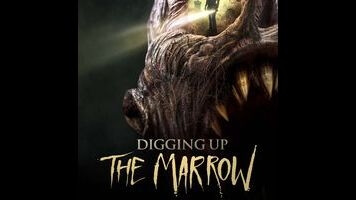Green plays himself as a classic genre-geek-turned-filmmaker, shuffling around production meetings and horror conventions in an Alamo Drafthouse T-shirt. With a little downtime on his hands, he enlists his longtime cinematographer and creative partner, Will Barratt, in a documentary project—modeled on trendy the-making-is-the-story docs like the original Catfish—about their kookiest fan (Ray Wise, the only cast member not playing himself), a retired detective convinced that he’s found evidence of an underground society of monsters. He lays the workings of which out with the pokey fussiness of a suburban neighbor explaining how to start his riding mower.
Digging Up The Marrow’s design is much more sophisticated than it might seem at first glance. At the bottom is a strictly conventional bump-in-the-night found-footage flick—the kind where people run from things they can’t see, swinging equipment wildly, or where they set down their camera in a leaf pile when they need to come in and take a closer look at something. This footage is framed through a mildly funny, character-centric faux-doc of the first-person variety, where the process of making the film is supposed to serve as a storytelling device; the movie’s first big jump scare, for instance, is followed by a scene of Green and real-life co-editor Josh Ethier going through the moment frame by frame.
Accumulated at the edges of this found-footage-mockumentary framework are pieces of straight-up non-fiction: observations about what’s it’s like to be creative in a fandom-driven business and about the appeal of monsters, interviews with artists and filmmakers, glimpses of life behind the scenes at horror conventions and in Green and Barratt’s production office. And there’s a complicating factor: Green is playing dumb, both in front of the camera and behind it; the movie’s few moments of skin-crawling creepiness come from those background details that the viewer can’t help but notice, but which the filmmakers—or “filmmakers”—clearly haven’t. (Additional complicating factor: Green isn’t a very good actor, and seems to know this.)
Interviewed in his nondescript California bungalow in front of one of those thumbtack-and-string map-and-photo collages that seem to be favored by serial killers and criminal profilers who think like serial killers, Wise’s Dekker—his name presumably a double homage to Monster Squad and Nightbreed—deadpans outlandish tales of monster metropolises, umbrella-headed succubi, and conjoined nightmares that crawl out of cemeteries at night. Green is his awkward, wide-eyed foil, which is a good way to set up punchlines, but also sets in motion a reversal of the fan-creator dynamic—which is fitting, because so much of Digging Up The Marrow plays like Green’s love letter to his fans and to the importance of fandom in genre filmmaking. There are autograph-line cameos (Tony Todd, Kane Hodder, Gwar’s dearly departed Oderus Urungus), a subplot involving the nonexistent third season of Green’s Holliston, and even a short montage of folks showing off Hatchet tattoos.
Green—the character, that is—fixates on Dekker’s stories because they offer the possibility of a cooler, weirder world than the one we live in (“I want to believe so wicked bad in this,” he blurts out at one point), and finds comfort in the idea that even if Dekker is putting the crew on, the fantasy he’s created is compelling on its own terms. In other words, he’s a genre fan, or the real Green’s idea of a genre fan. As far as ideas about fandom and horror go, it’s a little too simplistic—tidy to the point that it ends up becoming a constraint, neatly boxing in a movie that could otherwise grow outward.

